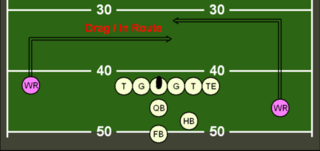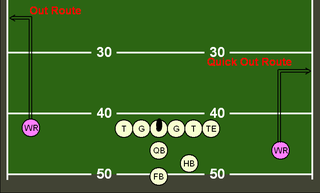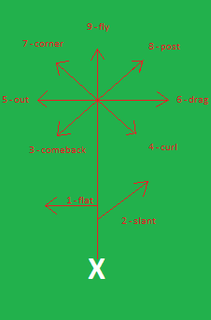
A running back (RB) is a gridiron football position, a member of the offensive backfield. The primary roles of a running back are to receive handoffs from the quarterback for a rushing play, to catch passes from out of the backfield, and to block. There are usually one or two running backs on the field for a given play, depending on the offensive formation. A running back may be a halfback, a wingback or a fullback. A running back will sometimes be called a "feature back" if he is the team's starting running back.

A cornerback (CB) is a member of the defensive backfield or secondary in gridiron football. Cornerbacks cover receivers most of the time, and defend against offensive plays by creating turnovers or deflecting forward passes rather than making a tackle. Other members of the defensive backfield include the safeties and occasionally linebackers. The cornerback position requires speed, agility, and strength. A cornerback's skill set typically requires proficiency in anticipating the quarterback, backpedaling, executing single and zone coverage, disrupting pass routes, block shedding, and tackling. Cornerbacks are among the fastest players on the field.

The tight end (TE) is a position in American football, arena football, and formerly Canadian football, on the offense. The tight end is often seen as a hybrid position with the characteristics and roles of both an offensive lineman and a wide receiver. Like offensive linemen, they are usually lined up on the offensive line and are large enough to be effective blockers. On the other hand, unlike offensive linemen, they are eligible receivers adept enough to warrant a defense's attention when running pass patterns.
A screen pass is a play in gridiron football consisting of a short pass to a receiver who is protected by a screen of blockers. During a screen pass, a number of things happen concurrently in order to fool the defense into thinking a long pass is being thrown, when in fact the pass is merely a short one, just beyond the defensive linemen. Screens are usually deployed against aggressive defenses that rush the passer. Because screens invite the defense to rush the quarterback, they are designed to leave fewer defensemen behind the rushers to stop the play.

A play-action pass is an American football play. The play action starts with what appears to be a running play, but turns out to be a pass play; in this way, it can be considered the opposite of a draw play. Play-action passes are often used against defenses that are focused on stopping the run. By initially simulating a running play, the offense attempts to deceive the defense into acting on the fake run and being out of position in their pass coverage, giving receivers more time and room to be free to receive passes behind the linebackers.
Strategy forms a major part of the game of American football, and both teams plan many aspects of their plays (offense) and response to plays (defense), such as what formations they take, who they put on the field, and the roles and instructions each player are given. Throughout a game, each team adapts to the other's apparent strengths and weaknesses, trying various approaches to outmaneuver or overpower their opponent to score more points in order to win the game.
The hook and lateral is a trick play in American, Canadian football & indoor American football, often colloquially called the hook and ladder play.
Bump and run coverage is a strategy often used by defensive backs in American football in which a defensive player lines up directly in front of a wide receiver and tries to impede him with arms, hands, or entire body and disrupt his intended route. This originated in the American Football League in the 1960s, one of whose earliest experts was Willie Brown of the Oakland Raiders. Mel Blount of the Pittsburgh Steelers specialized in this coverage to such a point as to cause a rule change to make it easier for receivers to run their routes and increase scoring.

A drag route is a route run by a receiver in American football, where the receiver runs a few yards downfield, then turns 90° towards the center of the field and runs parallel to the line of scrimmage. This type of route is relatively safe, and often leads to a receiver making a play after the catch. Alternatively, a drag route may be used as a second option if the principal receiver on a play is covered.

A fly route, also called a straight route, vertical route, streak route or go route, is a pattern run by a receiver in American football, where the receiver runs straight upfield towards the endzone. The goal of the pattern is to outrun any defensive backs and get behind them, catching an undefended pass while running untouched for a touchdown. Generally, the fastest receiver on the team or any receiver faster than the man covering him would be the one to run these routes. When run down the sidelines, a fly can be called a fade route.

A curl route, also called a hitch or hook, is a pattern run by a receiver in American football, where the receiver appears to be running a fly pattern but after a set number of steps or yards will quickly stop and turn around, looking for a pass. This generally works best when the defending corner or safety commits himself to guarding the fly and is unable to stop quickly enough to defend the pass. A "curl out" on the sideline is often referred to as a comeback route.

An out route is a pattern run by a receiver in American football. On an out route, the receiver will start running a fly pattern but, after a certain number of steps, will cut hard 90 degrees "to the outside", or toward the sideline, away from the quarterback. If the cut comes very quickly, usually after only a few steps, it is called a "quick out". Out routes generally allow a one-on-one match-up between the receiver and the defensive back who is guarding him, as safeties generally are concerned with helping out on long routes downfield or the center of the field.
In American football a play is a close to the ground "plan of action" or "strategy" used to move the ball down the field. A play begins at either the snap from the center or at kickoff. Most commonly plays occur at the snap during a down. These plays range from basic to very intricate. Football players keep a record of these plays in their playbook.

A wheel route is a pattern run by a receiver or running back in American football. If a receiver runs it, they will immediately run a quick out pattern, then proceed to turn upfield in a curved pattern. Typically this route is run by an inside receiver, with the number one receiver heading inside to exploit coverage in the defense. When run from the running back position the player will run towards the sideline while looking back at the quarterback as if about to receive a pass on a flare route. The running back will then turn upfield at the sideline and run straight down the field.

A flat route is an American football route, used in passing plays. A flat route is usually run by a running back or a fullback. When run by a receiver it can be known as a speed out or arrow route. The eligible receiver runs parallel to the line of scrimmage till near the sidelines and turns toward the quarterback to wait for the pass. The QB's pass should arrive when he is not yet past the line of scrimmage. The receiver will then turn upfield at the sideline and run straight down the field.
The flat in gridiron football is the area of the field extending ten yards into the defensive backfield from the line of scrimmage and extending outside the hash marks to the out-of-bounds lines.
The run and shoot offense is an offensive system for American football which emphasizes receiver motion and on-the-fly adjustments of receivers' routes in response to different defenses. It was conceived by former high school coach Glenn "Tiger" Ellison and refined and popularized by former Portland State offensive coordinator Mouse Davis.
A play calling system in American football is the specific language and methods used to call offensive plays.












